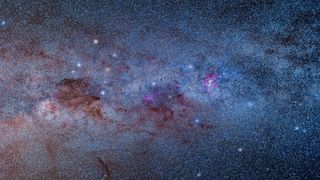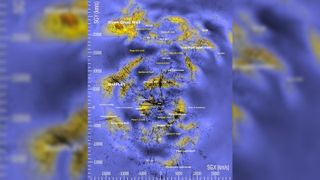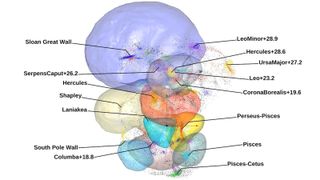The Milky Way could be part of a much larger 'cosmic neighborhood' than we realized, challenging our understanding of the universe
A probabilistic new map of the universe surrounding the Milky Way reveals that our galaxy is likely part of an even larger "basin of attraction" than we previously assumed.

The region of the universe we live in may be significantly bigger than we thought. A new study reveals that the intergalactic supercluster holding the Milky Way may be part of an even bigger "basin of attraction" that's up to 10 times larger than the one we currently call home.
The universe is full of basins of attraction (BOAs) — regions within which everything is being pulled inward by the gravity of a massive object. BOAs can stack inside one another like nesting dolls. For example, the moon circles Earth, which in turn orbits the sun along with the rest of the solar system, which is itself spiraling around the supermassive black hole at the heart of our galaxy.
But the story doesn't end there. The next layer of the BOA doll is the Local Group, which includes the Milky Way, the Andromeda Galaxy and the Triangulum Galaxy, along with their smaller satellite galaxies such as the Large and Small Magellanic Clouds. After that, the next layers are the Virgo Cluster, which holds around 2,000 galaxies, and the larger Virgo Supercluster. The final known layer is Laniākea (meaning "immense heaven" in the Hawaiian language) — a supercluster first discovered in 2014, which holds around 100,000 galaxies and spans roughly 500 million light-years across.
But in the new study, published Sept. 27 in the journal Nature Astronomy, researchers analyzed the relative movements of more than 56,000 galaxies to create a 3D "probabilistic" map of all the BOAs surrounding the Milky Way. This revealed that there is a decent chance our home galaxy is part of an even larger BOA — the Shapley Concentration — that has a volume up to 10 times greater than Laniākea. (Scientists already knew the Shapley Concentration existed but did not previously believe it impacted the Milky Way.)
Related: Cosmic record holders: The 12 biggest objects in the universe

"It is perhaps unsurprising that the further into the cosmos we look, we find that our home supercluster is more connected and more extensive than we thought," study co-author Noam Libeskind, a cosmologist at the Leibniz Institute for Astrophysics Potsdam in Germany, said in a statement. "Discovering that there is a good chance that we are part of a much larger structure is exciting."
At the moment, the researchers — most of whom were involved in the discovery of Laniākea — believe there is a 60% chance that the Milky Way resides in the Shapley Concentration. The uncertainty is largely caused by high error rates in measuring the speeds of distant galaxies, as well as the presence of dark matter between galaxies, which can exert massive gravitational effects across large regions of space without being visible.
Sign up for the Live Science daily newsletter now
Get the world’s most fascinating discoveries delivered straight to your inbox.
If true, the new findings could also mean that the Milky Way is not part of Laniākea and that the heavenly supercluster might not even exist. Instead, it could just be an outer section of the Shapley Concentration, the researchers wrote in the statement.

The map shows dozens of objects spread out across billions of light-years around the Shapley Concentration, such as the South Pole Wall, the Boötes Void and the Perseus-Pisces Supercluster. The largest BOA on the map is the Sloan Great Wall, which stretches around 1.4 billion light-years across.
While the new map helps us to better pinpoint our place in the wider universe, it also raises the possibility that we could be missing even more information, the researchers wrote.
"This discovery presents a challenge: our cosmic surveys may not yet be large enough to map the full extent of these immense basins," study co-author Ehsan Kourkchi, an astronomer at the University of Hawai'i, said in another statement. "We are still gazing through giant eyes, but even these eyes may not be big enough to capture the full picture of our universe."
You can check out an interactive version of the new map below. The differently colored blobs represent different basins of attraction (light yellow is the Shapley Concentration, blue is Laniākea and red is the Sloan Great Wall). The Milky Way is located at the intersection of the red, blue and green arrows.

Harry is a U.K.-based senior staff writer at Live Science. He studied marine biology at the University of Exeter before training to become a journalist. He covers a wide range of topics including space exploration, planetary science, space weather, climate change, animal behavior and paleontology. His recent work on the solar maximum won "best space submission" at the 2024 Aerospace Media Awards and was shortlisted in the "top scoop" category at the NCTJ Awards for Excellence in 2023. He also writes Live Science's weekly Earth from space series.